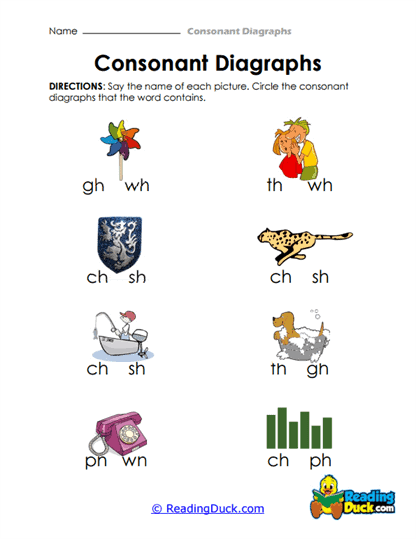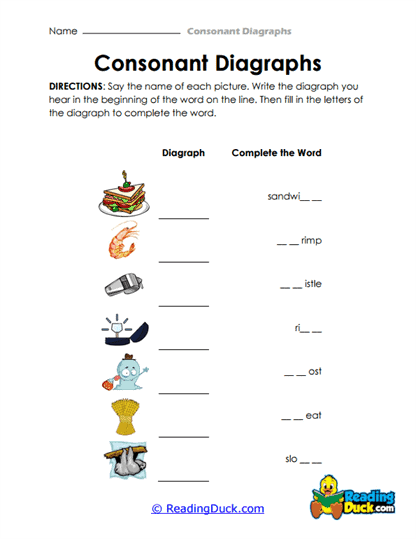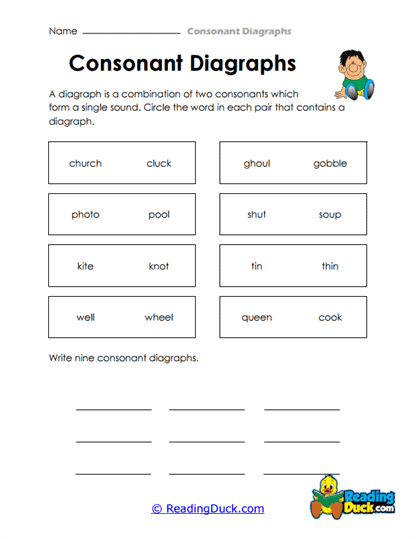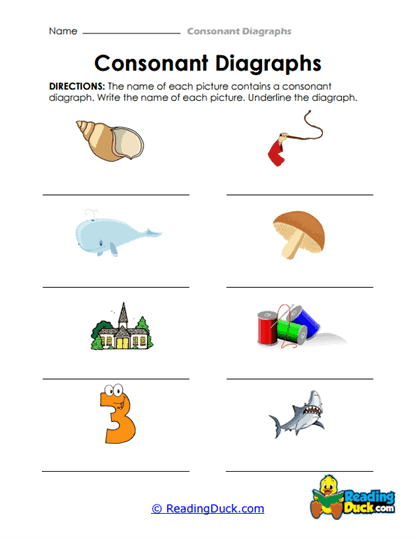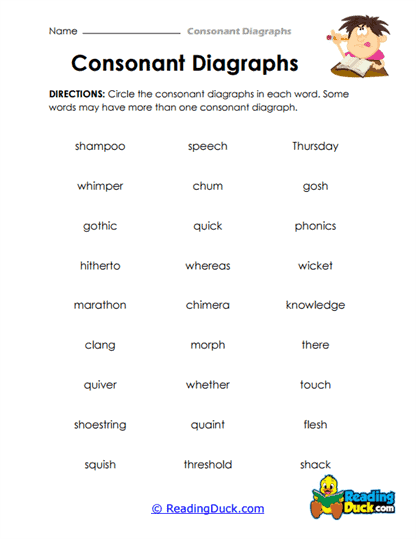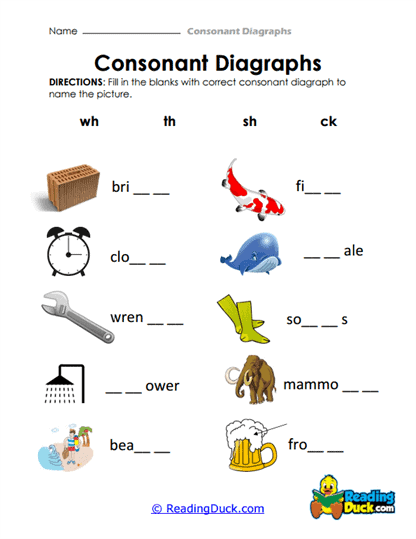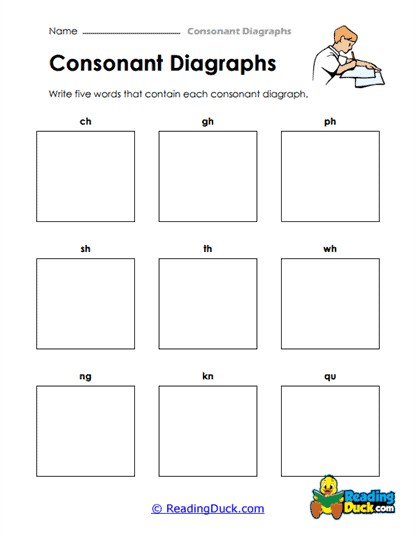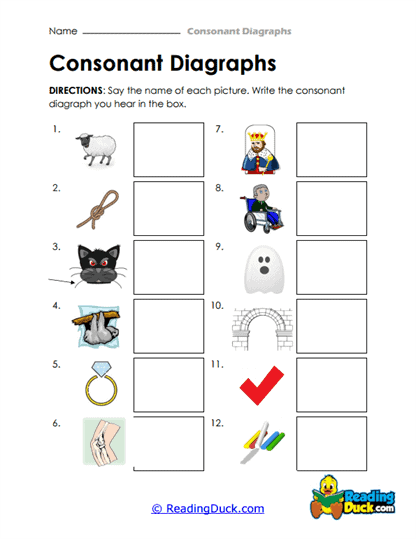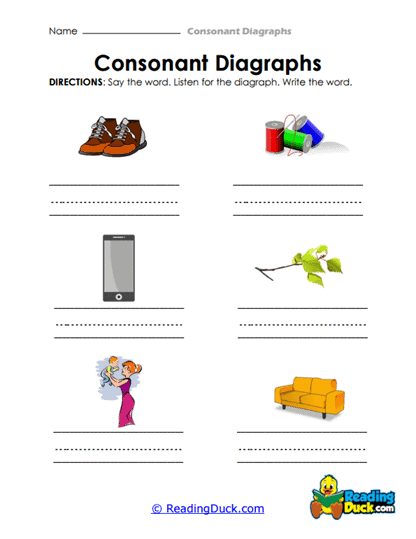Consonant Digraphs Worksheets
About Our Consonant Digraphs Worksheets
Our Consonant Digraphs Worksheets are designed to help young learners master the concept of consonant digraphs, a critical element in phonics and early reading development. These worksheets are categorized under the 'Phonics' section within the 'Pre-Reading' category, making them ideal for students in grades 1 through 3. Available in a convenient PDF format, these worksheets are easy to view, download, and print, providing flexibility for both classroom instruction and home learning. Each worksheet comes with a downloadable answer key, enabling educators and parents to assess students’ understanding and progress effectively.
Understanding Consonant Digraphs: A Key Phonics Concept
Consonant digraphs are an essential component of phonics instruction, and understanding them is crucial for early reading success. Let’s explore what consonant digraphs are, why they are important, and how they support a child’s journey toward becoming a proficient reader.
What Are Consonant Digraphs?
A consonant digraph is a combination of two consonants that work together to produce a single sound, distinct from the sounds each letter makes individually. For example:
- "Sh" in "ship": The letters "s" and "h" come together to create the /sh/ sound.
- "Ch" in "chop": The letters "c" and "h" combine to produce the /ch/ sound.
- "Th" in "thin": The letters "t" and "h" form the /th/ sound.
These digraphs are different from blends, where each consonant sound is heard separately. In a digraph, the two letters create a new, single sound.
Why Are Consonant Digraphs Important?
- Facilitates Word Recognition: Mastery of consonant digraphs helps students recognize and pronounce common words more easily, enhancing their reading fluency.
- Supports Accurate Spelling: Understanding digraphs is crucial for spelling, as it helps students remember how specific sounds are represented by letter combinations.
- Builds a Foundation for Advanced Phonics: Knowledge of digraphs lays the groundwork for more advanced phonics concepts, including multisyllabic words and complex spelling patterns.
- Expands Vocabulary: As students learn to decode and spell words containing consonant digraphs, they naturally expand their vocabulary, improving their overall language skills.
How These Worksheets Reinforce Consonant Digraphs
Our Consonant Digraphs Worksheets are specifically designed to help students practice and internalize the concept of consonant digraphs. Here’s how these worksheets support phonics instruction and enhance reading skills.
Systematic and Comprehensive Practice
The worksheets offer systematic practice that focuses on recognizing, reading, and writing consonant digraphs. This structured approach ensures that students gain a solid understanding of digraphs and can apply this knowledge to decode words effectively.
Interactive and Engaging Exercises
These worksheets are crafted to be interactive and engaging, encouraging students to participate actively in their learning. By identifying digraphs, completing word puzzles, and matching words to their digraphs, students reinforce their understanding in a fun and meaningful way.
Tailored for Different Learning Stages
The worksheets are adaptable for students at various stages of learning. Whether a student is just beginning to learn about digraphs or is ready for more challenging activities, these worksheets provide a versatile tool that can be adjusted to meet individual needs.
Reinforcement Through Repetition
Repetition is key to mastering phonics concepts. The worksheets provide repeated exposure to consonant digraphs in different contexts, helping students to internalize the sounds and spelling patterns associated with each digraph.
Primary Learning Objectives for Consonant Digraphs Worksheets
The Consonant Digraphs Worksheets are designed with clear learning objectives that aim to build phonics skills and improve reading fluency. The main goals of these worksheets include:
- Recognize and Identify Common Consonant Digraphs: The worksheets help students accurately recognize and identify common consonant digraphs within words.
- Enhance Decoding Skills: By practicing with consonant digraphs, students will improve their ability to decode unfamiliar words, which is crucial for reading fluency and comprehension.
- Improve Spelling Accuracy: Understanding how consonant digraphs are used in words supports students in spelling them correctly, leading to better writing skills.
- Develop Reading Fluency: As students become more familiar with consonant digraphs, they will be able to read more fluently, with greater speed and accuracy.
- Expand Vocabulary and Language Proficiency: Through exposure to words that contain consonant digraphs, students will naturally expand their vocabulary and improve their overall language proficiency.
Strategies for Effectively Using Consonant Digraphs Worksheets
To maximize the effectiveness of these worksheets, educators and parents can implement the following strategies:
Incorporate Digraph Practice into Daily Lessons
Regular practice is essential for mastering consonant digraphs. Incorporate these worksheets into daily phonics lessons, morning literacy routines, or as part of homework assignments to reinforce learning.
Combine with Oral and Visual Phonics Activities
Pair the worksheets with oral phonics activities, such as reading aloud words with digraphs or playing phonics games that focus on digraphs. Visual activities, like using flashcards with digraph examples or creating word walls, can also support the learning process.
Scaffold Instruction for Differentiated Learning
Different students may grasp digraphs at varying rates, so it’s important to provide scaffolding to meet each learner’s needs. Offer additional support for students who struggle with digraphs, such as breaking down the words into smaller parts or using visual aids to reinforce the sounds.
Encourage Collaborative Learning
Collaborative learning can be beneficial in phonics instruction. Encourage students to work together on the worksheets, discussing and exploring consonant digraphs in pairs or small groups. This interaction can enhance understanding and make learning more engaging.
Provide Immediate Feedback and Reinforcement
Use the answer keys provided with the worksheets to give students prompt feedback on their work. Discussing their responses and the reasoning behind them helps reinforce the correct use of consonant digraphs and addresses any misconceptions.
Incorporate Multisensory Learning Techniques
Multisensory approaches can enhance the learning experience by engaging multiple senses. For example, students can use letter tiles to physically construct words with consonant digraphs or create drawings that represent words containing specific digraphs.
The Role of Consonant Digraphs Worksheets in Phonics Instruction
Incorporating Consonant Digraphs Worksheets into a comprehensive phonics program offers numerous benefits for developing early reading and writing skills. Here’s how these worksheets contribute to a robust phonics education:
Building a Solid Foundation for Reading
Understanding consonant digraphs is fundamental to decoding and reading proficiency. These worksheets provide the practice needed to establish a strong foundation, enabling students to approach reading tasks with confidence.
Enhancing Reading Fluency and Comprehension
Fluency in reading is closely linked to the ability to recognize and pronounce consonant digraphs quickly and accurately. By practicing with these worksheets, students develop the skills needed to read more fluently and with greater comprehension.
Supporting Diverse Learning Needs
The versatility of the Consonant Digraphs Worksheets makes them suitable for a wide range of learners, including those who may need extra support with phonics concepts. The worksheets can be tailored to fit different learning styles and paces, ensuring that all students benefit from the instruction.
Preparing Students for More Advanced Phonics Concepts
Mastery of consonant digraphs prepares students for more complex phonics concepts, such as multisyllabic words and intricate spelling patterns. The skills acquired through these worksheets lay the groundwork for continued success in reading and writing.
Promoting Lifelong Literacy Skills
By helping students understand and apply the concept of consonant digraphs, these worksheets contribute to the development of lifelong literacy skills. Students who are proficient in recognizing and using consonant digraphs are better equipped to tackle more challenging texts and expand their language abilities.
In conclusion, our Consonant Digraphs Worksheets are an invaluable resource for developing essential phonics skills. By focusing on the identification and application of consonant digraphs, these worksheets provide young learners with the tools they need to become confident and proficient readers and spellers. Whether used in the classroom, at home, or in tutoring sessions, these worksheets are designed to support the development of strong, foundational literacy skills that are crucial for reading success.
